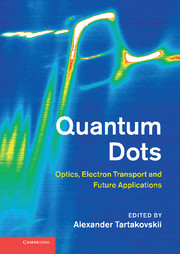Book contents
- Frontmatter
- Contents
- List of contributors
- Preface
- Part I Nanostructure design and structural properties of epitaxially grown quantum dots and nanowires
- Part II Manipulation of individual quantum states in quantum dots using optical techniques
- Part III Optical properties of quantum dots in photonic cavities and plasmon-coupled dots
- 8 Deterministic light–matter coupling with single quantum dots
- 9 Quantum dots in photonic crystal cavities
- 10 Photon statistics in quantum dot micropillar emission
- 11 Nanoplasmonics with colloidal quantum dots
- Part IV Quantum dot nano-laboratory: magnetic ions and nuclear spins in a dot
- Part V Electron transport in quantum dots fabricated by lithographic techniques from III–V semiconductors and graphene
- Part VI Single dots for future telecommunications applications
- Index
- References
9 - Quantum dots in photonic crystal cavities
from Part III - Optical properties of quantum dots in photonic cavities and plasmon-coupled dots
Published online by Cambridge University Press: 05 August 2012
- Frontmatter
- Contents
- List of contributors
- Preface
- Part I Nanostructure design and structural properties of epitaxially grown quantum dots and nanowires
- Part II Manipulation of individual quantum states in quantum dots using optical techniques
- Part III Optical properties of quantum dots in photonic cavities and plasmon-coupled dots
- 8 Deterministic light–matter coupling with single quantum dots
- 9 Quantum dots in photonic crystal cavities
- 10 Photon statistics in quantum dot micropillar emission
- 11 Nanoplasmonics with colloidal quantum dots
- Part IV Quantum dot nano-laboratory: magnetic ions and nuclear spins in a dot
- Part V Electron transport in quantum dots fabricated by lithographic techniques from III–V semiconductors and graphene
- Part VI Single dots for future telecommunications applications
- Index
- References
Summary
Introduction
During the past two decades, the development of micro- and nano-fabrication technologies has positively impacted multiple areas of science and engineering. In the photonics community, these technologies had numerous early adopters, which led to photonic devices that exhibit features at the nano-scale and operate at the most fundamental level of light–matter interaction [28, 39, 18, 29]. One of the leading platforms for these types of devices is based on gallium arsenide (GaAs) planar photonic crystals (PC) with embedded indium arsenide (InAs) quantum dots (QDs). The PC architecture is advantageous because it enables monolithic fabrication of photonic networks for efficient routing of light signals of the chip [26]. At the same time, PC devices have low loss and ultra-small optical mode volumes, which enable strong light–matter interactions. The InAs quantum dots are well suited for quantum photonic applications because they have excellent quantum efficiencies, large dipole moments, and a variety of quantum states that can be optically controlled [24, 3].
Currently, the development of these photonic technologies is geared mainly towards applications in quantum and classical information processing. The first proposals for quantum information processing using QDs in optical microresonators were developed more than a decade ago in the broader context of quantum information processing using quantum systems (such as atoms, ion, molecules) that can be optically controlled [23, 17]. Compared to other systems, the solid-state quantum photonic platform is attractive for quantum information applications because of its potential for large-scale integration [27].
- Type
- Chapter
- Information
- Quantum DotsOptics, Electron Transport and Future Applications, pp. 153 - 168Publisher: Cambridge University PressPrint publication year: 2012



